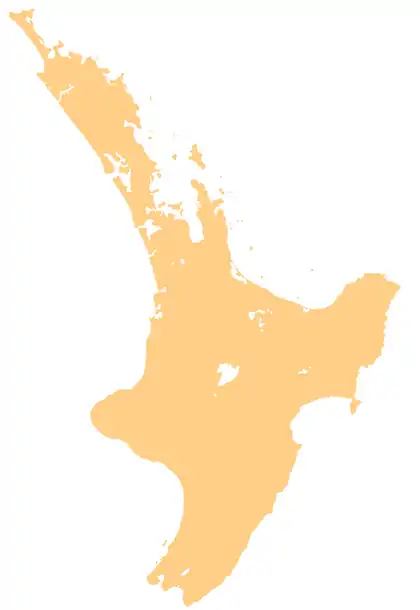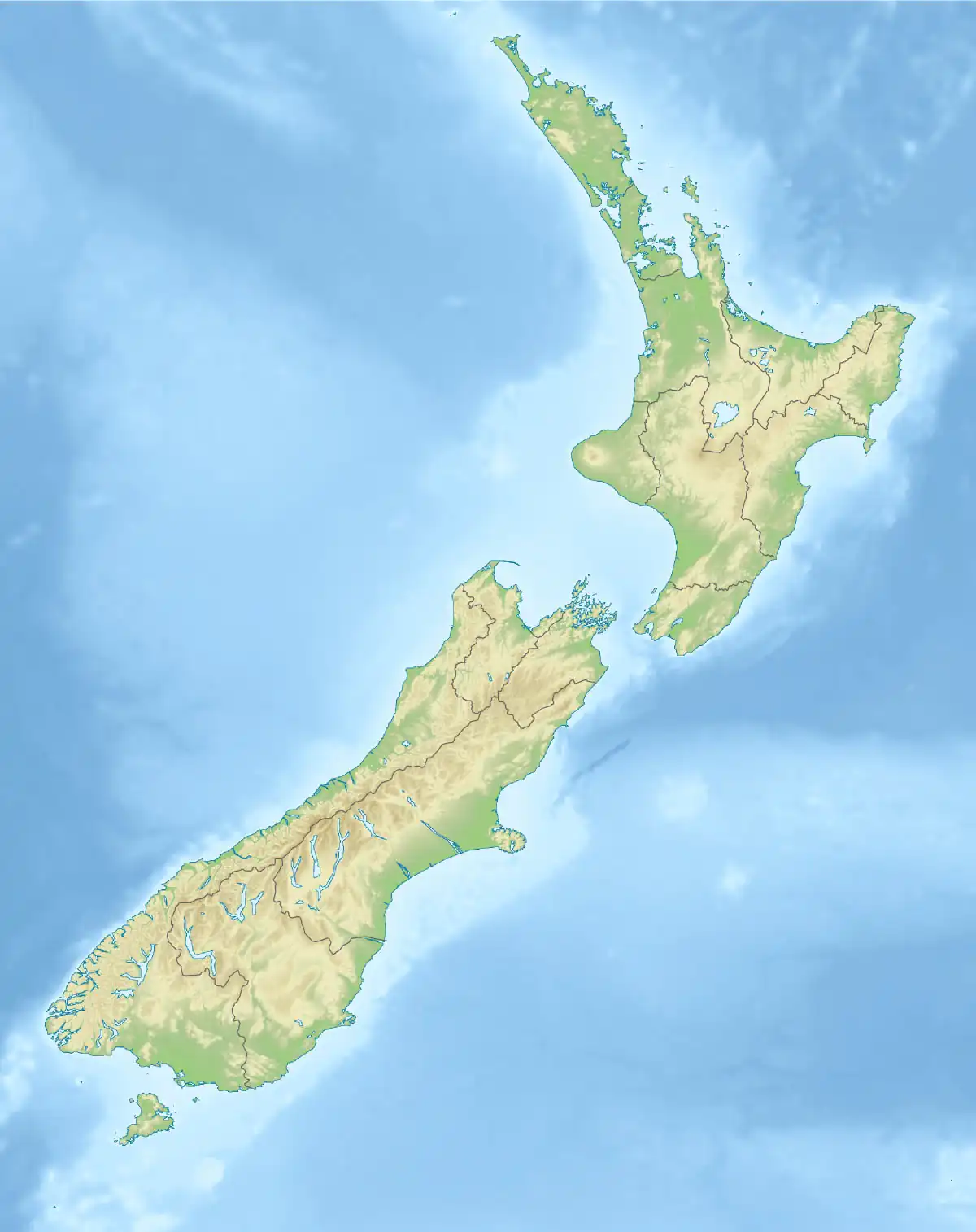| Puhipuhi Embayment | |
|---|---|
| Puhipuhi Basin | |
 Okataina Volcanic Centre (approximate thick white border) relationships to other nearby volcanic and tectonic structures. The Puhipuhi Embayment is to its east. | |
| Highest point | |
| Elevation | 364 m (1,194 ft)[1] |
| Prominence | Puhipuhi |
| Coordinates | 38°10′41″S 176°36′27″E / 38.177953°S 176.607628°E |
| Dimensions | |
| Width | 8 km (5.0 mi) |
| Geography | |
 Puhipuhi Embayment (North Island) | |
| Country | New Zealand |
| Region | Waikato |
| Range coordinates | 38°10′37″S 176°36′00″E / 38.177°S 176.6°E |
| Geology | |
| Age of rock | |
| Mountain type | Caldera collapse |
| Volcanic region | Taupō Volcanic Zone |
| Last eruption | 31,500 ± 5,200 years ago[3][notes 1] |
| Climbing | |
| Access | Restricted |
The Puhipuhi Embayment (also Puhipuhi Basin) is a volcanic feature in Taupo Volcanic Zone of New Zealand associated with the collapse of the Ōkataina Caldera wall to its west.[2] Its latest significant volcanic eruption was about 31,500 years ago[3] and this dating required a reassessment of recent activity at the Eastern extension of the Tarawera vent alignment.[4][5][6]
Geography
The Puhipuhi Embayment extends from the eastern margin of Mount Tarawera towards Kawerau including land mostly devoted to the Tarawera Forest portion of the Kaingaroa Forest. The basin is a dissected plateau at about 200 m (660 ft) above sea level.[4] The Tarawera River cuts through the north of the basin and is its drainage.
Geology
Both the Pupipuhi Embayment and the Tarawera Volcanic Complex are part of the Ōkataina Volcanic Centre. There is a long eruptive history with the likelihood that some of the 13 Mangaone Subgroup eruptions were from vents in the embayment[7] and the only dacite eruptives from this centre occur in the south of the embayment. Volcanism within and near such collapse structure embayments associated with the volcanic centre is predominately rhyolitic and Matahina ignimbrite is exposed north of the Tarawera River in the embayment, Rotoiti ignimbrite at its southern margins and Kawerau ignimbrite at its centre.[2] The basins Kawerau Ignimbrite is dated to about 31.5 ka[3] and overlies both the much older Matahina ignimbrite (about 280 ka), the relatively recent Rotoiti ignimbrite and also most of the tephras of the 43-31 ka Mangaone Subgroup. Kawerau Ignimbrite is the youngest partially-welded ignimbrite in the Taupō Volcanic Zone.[4] Puhipuhi dacite is found in a small cone and lavas that were intruded in to lake sediments and are usually overlain by Mangaone Subgroup tephras and assigned about 1000 years before the Rotoiti eruption as they are overlaid by this as well.[4] Utu ignimbrites are exposed in small outcrops within the Puhipuhi embayment.[8]
Activity
An example of probably basaltic dyke intrusion that never reached the surface, but propagated towards Mount Tarawera, was manifest as an earthquake swarm under the embayment during a recent period of volcanic unrest.[9]
Notes
- ↑ The age of Kawerau ignimbrite in the middle of the Puhipuhi Embayment was established by Spinks in 2005 to be 33 ka, a major revision on Beresford & Cole who in 2000 had reclassified it from Kaingaroa Ignimbrite but retained a much older age of 240 ka based of other sampling of Ignimbrite. Spinks noted that the composition of Kawerau ignimbrite was identical to the unit I eruptives of the Mangaone Subgroup tephra, which had been independently dated and was distinct from the other layers. Danišík in 2020 updated the dates and composition of the 13 Mangaone Subgroup tephras and this revised, more accurate date than the methodology available to Spinks is used here. The methodology of the Lowe/Danišík group gives earlier ages to the Rotoiti tephra than the other dating methods used on Rotoiti ignimbrite although confidence limits almost overlap. For technical reasons the Lowe/Danišík results are now consistent at younger ages but are believed by some to underestimate ages from about the 50 ka mark. For reference since the Rotoiti and Manganone subgroup eruptives are found in the Embayment, the current Lowe/Danišík Bayesian age sequence model as of 2020 dates the Rotoiti eruptives at 46.8 ka (51 - 43.8), Unit A of Manganone subgroup to 42.7 ka (46.4 - 39.2) and Unit L of Manganone subgroup to 30.6 ka (31.2 - 29.1). For more on this age issue see notes to Ōkataina Caldera and Rotoiti Caldera.
References
- ↑ "NZTopoMap:Puhipuhi".
- 1 2 3 Hughes, Ery C.; Law, Sally; Kilgour, Geoff; Blundy, Jon D.; Mader, Heidy M. (2023). "Storage, evolution, and mixing in basaltic eruptions from around the Okataina Volcanic Centre, Taupō Volcanic Zone, Aotearoa New Zealand". Journal of Volcanology and Geothermal Research. 434 (107715): 107715. doi:10.1016/j.jvolgeores.2022.107715. hdl:20.500.11820/9f5c151c-1f2e-47ed-a264-7649eacdf669. ISSN 0377-0273. S2CID 253783414.
- 1 2 3 Danišík, Martin; Lowe, David J.; Schmitt, Axel K.; Friedrichs, Bjarne; Hogg, Alan G.; Evans, Noreen J. (2020). "Sub-millennial eruptive recurrence in the silicic Mangaone Subgroup tephra sequence, New Zealand, from Bayesian modelling of zircon double-dating and radiocarbon ages" (PDF). Quaternary Science Reviews. 246: 106517. doi:10.1016/j.quascirev.2020.106517. hdl:10289/13801. ISSN 0277-3791. S2CID 224864954.
- 1 2 3 4 Spinks, Karl D. (2005). Rift Architecture and Caldera Volcanism in the Taupo Volcanic Zone, New Zealand (Thesis).
- ↑ Cole, J. W.; Spinks, K. D. (2009). "Caldera volcanism and rift structure in the Taupo Volcanic Zone, New Zealand". Special Publications. London: Geological Society. 327 (1): 9–29. Bibcode:2009GSLSP.327....9C. doi:10.1144/SP327.2. S2CID 131562598.
- ↑ Hodgson, K. A.; Nairn, I. A. (August 2004). "The Sedimentation and Drainage History of Haroharo Caldera and The Tarawera River System, Taupo Volcanic Zone, New Zealand" (PDF). Operations Publication 2004/03. Environment Bay of Plenty: 7. ISSN 1176-5550. Archived from the original (PDF) on 2010-05-22.
- ↑ Rooyakkers, S.M.; Faure, K.; Chambefort, I.; Barker, S.J.; Elms, H.C.; Wilson, C.J.; Charlier, B.L. (2023). "Tracking Magma‐Crust‐Fluid Interactions at High Temporal Resolution: Oxygen Isotopes in Young Silicic Magmas of the Taupō Volcanic Zone". Geochemistry, Geophysics, Geosystems. 24 (1). doi:10.1029/2022GC010694. S2CID 254807245.
- ↑ Miller, Craig A.; Barretto, Jenny; Stagpoole, Vaughan; Caratori-Tontini, Fabio; Brakenrig, Thomas; Bertrand, Edward (2022). "The integrated history of repeated caldera formation and infill at the Okataina Volcanic Centre: Insights from 3D gravity and magnetic models". Journal of Volcanology and Geothermal Research. 427: 107555. doi:10.1016/j.jvolgeores.2022.107555. ISSN 0377-0273. S2CID 248361982.
- ↑ Benson, Thomas W.; Illsley-Kemp, Finnigan; Elms, Hannah C.; Hamling, Ian J.; Savage, Martha K.; Wilson, Colin J. N.; Mestel, Eleanor R. H.; Barker, Simon J. (2021). "Earthquake Analysis Suggests Dyke Intrusion in 2019 Near Tarawera Volcano, New Zealand". Frontiers in Earth Science. 8. doi:10.3389/feart.2020.606992. ISSN 2296-6463.
